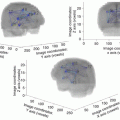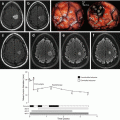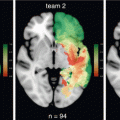© Springer-Verlag London Ltd. 2017
Hugues Duffau (ed.)Diffuse Low-Grade Gliomas in Adults10.1007/978-3-319-55466-2_11. Introduction: From the Inhibition of Dogmas to the Concept of Personalized Management in Patients with Diffuse Low-Grade Gliomas
(1)
Department of Neurosurgery, Gui de Chauliac Hospital, CHU Montpellier, Montpellier University Medical Center, 80, Avenue Augustin Fliche, 34295 Montpellier, France
(2)
Institute for Neurosciences of Montpellier, INSERM U1051, Team “Plasticity of Central Nervous System, Human Stem Cells and Glial Tumors,” Saint Eloi Hospital, Montpellier University Medical Center, Montpellier, France
Abstract
Recent technical and conceptual advances in genetics, cognitive neurosciences, imaging, and treatments have revolutionized our understanding of diffuse low-grade glioma, leading to challenge dogmas and to the fundamental concept of personalized management. Moreover, a better knowledge of the brain connectome and neuroplasticity enables us to take into consideration interactions between the disease (the glioma) and the host (the brain), and thus to elaborate dynamic and multimodal therapeutic strategies with the goal to increase the median survival as well as to improve the quality of life – that is, to move toward a “functional neurooncology”. In the era of “evidence-based medicine”, it is crucial not to forget “individual-based medicine”.
Keywords
Diffuse low-grade gliomapersonalized managementindividual-based medicinefunctional neurooncologybrain plasticity
“opheléein ê mê blaptein” (first be useful, then do not be harmful)
Hippocrate
Supratentorial diffuse low-grade glioma (DLGG) is a rare and complex entity in adults, which has been matter of debate for many decades. This controversy was due to several factors. First, for a long time, the natural course of this disease has been poorly investigated and thus it was poorly understood. In the classical literature, most of authors considered DLGG as a “stable” and even as a “benign” brain tumor. As a consequence, the “wait and see” policy was traditionally advocated, due to the theoretical risk of treatment(s) in young adults usually enjoying a “normal life”. In other words, from a functional point of view, the dogma was to claim that these patients “are doing well”, because they have generally no deficit on a standard neurological examination (even if they are in rule under anti-epileptic drug(s) due to inaugural seizures in 80–90% of cases). Furthermore, medical and surgical neurooncologists also believed that it was almost impossible to remove this kind of tumors without generating functional deficits—especially when located within the so-called “eloquent areas”, as frequently observed. Above all, it was argued that surgical removal, mainly based on the subjective estimation of the extent of resection by neurosurgeons, had no impact on the natural history of DLGG, and that the most appropriate management was therefore to achieve only a biopsy with the aim of obtaining neuropathological examination—in order to decide whether a simple follow-up could be considered or whether radiotherapy should be performed. This means that the treatment was selected almost exclusively on the basis of the morphological criteria according to the previous WHO classification (astrocytoma versus oligodendroglioma versus mixed glioma; grade II versus III). Finally, the clinical results were evaluated in the vast majority of series on only few parameters, that is, the progression free survival (PFS), overall survival (OS), and, optionally, Karnofsky Performance Scale.
In this book, breaking with the traditional conservative attitude, the aim is to comprehensively review recent technical and conceptual advances in genetics, cognitive neurosciences, imaging and treatments that have revolutionized our understanding of DLGG, leading to the fundamental principle of personalized active and dynamic therapeutic strategies. In addition, beyond the pure oncological considerations, a better knowledge of brain processing enables now to take into consideration interaction between the disease (the glioma) and the host (the brain), and thus to modulate the therapeutic strategies with the goal to increase the median survival as well as to improve the quality of life—i.e. to solve the classical dilemma opposing the increase of OS versus the preservation of cerebral functions [1]. In this setting, the purpose of this 2nd Edition is to revisit the biology, behavior and management of DLGG, in order to open new avenues to the origins of this tumor, its natural history, as well as the present and future regarding individualized therapeutic attitudes.
In fact, based on a large amount of original data published in the last decade, it is time to inhibit the traditional dogmas and to evolve towards a paradigmatic shift in the comprehension and the treatment of this disease. First, in this textbook, it will be demonstrated that this tumor is not stable but that it has a constant growth and migration along the subcortical pathways, with, ultimately, a malignant transformation leading to neurological deficits and death—with a median survival about 6–7 years [1]. Therefore, it is crucial to better investigate the natural course of the glioma at the individual level by calculating the velocity diameter expansion before any treatment, because this is a major prognostic factor, i.e. one of the best predictor of OS [2, 3]. In a series of 34 patients, it was observed that tumor growth within 6 months was better than baseline volumes, relative cerebral blood volume, or apparent diffusion coefficient in predicting time to malignant transformation in untreated DLGGs and was independent of other parameters [4]. Furthermore, the spontaneous velocity of diametric expansion is also a predictor independent of molecular marker, as IDH1 mutation status [5]. As a practical consequence, the spontaneous growth rate should be measured systematically at the beginning of the management of a DLGG without delaying treatment and should be added to the other known risk parameters to adapt treatment and follow-up on an individual basis.
Moreover, neurooncologists have to understand that this glioma is not a “tumor mass” compressing the parenchyma, but that this diffuse lesion is in fact an infiltrative disease of the brain, extending far away beyond the abnormalities visible on neuroimaging [6]. It was previously thought that the abnormalities visible on neuroimaging (as hypersignal on FLAIR-weighted MRI) corresponded to the whole disease (associated with oedema), leading to speak about “normal brain” around these signal abnormalities—which is totally wrong. This issue is crucial for the therapeutic (as surgical and radiation) management: indeed, a resection cannot be achieved according to “oncological” limits issued from radiological examination (as preoperative MRI, intrasurgical neuronavigation or intraoperative neuroimaging) because this information is not the reflect of the entire glioma, but only the tip of iceberg [7]. In the same spirit, with respect to tumor monitoring, new endpoints will be proposed, due to the fact that PFS is thus meaningless in DLGG before any treatment or after an incomplete surgical resection, since in essence all DLGGs are continuously growing (whereas this endpoint would be unambiguous after a “total resection” or could be also more or less properly defined under adjuvant treatment such as chemotherapy/radiotherapy). In this context, the classical radiological criteria, as initially proposed by Mac Donald [8] or more recently by the RANO group [9], are not appropriate to monitor DLGG kinetics. It will be demonstrated that an objective and accurate 3D volumetric assessment should be performed for each examination on FLAIR-weighted MRI, with computation of a individual growth rate before and after each therapy [10, 11]. New metabolic criteria will also be helpful to increase the sensitivity of this radiological monitoring.
From a functional point of view, it will be shown in this textbook that, contrary to conventional wisdom, these patients have generally neurocognitive and/or mood disorders at the time of diagnosis, including in cases of incidental DLGG [12]. These deficits are mainly related to the migration of the tumoral cells along the white matter tracts, thus limiting the potential of neuroplasticity due to the invasion of the brain connectome [13, 14]. Longitudinal neuropsychological assessments have shown a worsening in high cognitive functions, as non verbal delay recall scores, after a one year « wait and see » follow-up [15]. These results plead against a conservative attitude in DLGG patients, not only for oncological purpose but also with regard to the health related quality of life (QoL). Thus, neuropsychological examination should be systematically performed before and after each treatment—the classical neurological examination being not sensitive enough to objectively evaluate DLGG patients [16]. Indeed, the presence of an abnormal baseline cognitive score is a strong predictor of poorer OS in DLGG patients [17]. This issue is very important to tailor the management with the aim not only of increasing OS but also of optimizing the duration with a normal QoL: for example, by minimizing the rate of postoperative deficit by means of intrasurgical electrical mapping in order to preserve the neural networks essential for brain functions [18]; or by preventing the long-term negative consequences of radiotherapy on high cognitive functions by avoiding early irradiation [19].
On the lights of this better knowledge of natural history, original individualized and multimodal therapeutic attitudes will be proposed in this book. Regarding surgery, its first aim is to allow an extensive histomolecular examination in DLGG, knowing that this is a heterogeneous tumor: many gliomas may exhibit “more aggressive” micro-foci in the core of a “low-grade” glioma [20]. In practice, this is the reason why, each time surgical resection is feasible, biopsy should be avoided, due to its high risk of under-quotation. Furthermore, in the past decade, numerous evidences have supported the significant impact of maximal resection on the course of DLGG, by delaying malignant transformation and therefore by increasing median survival [21–23]. Interestingly, although OS was around 6–7 years in series with a simple biopsy [24, 25], OS was significantly increased to 14–15 years in surgical series based upon early and maximal resection, as reported by the French Glioma Consortium about over one thousand DLGG [26]. In other words, radical resection is able to approximately double the survival—thanks to an impact of surgery per se, independently of the molecular profile of the DLGG [27]. Interestingly, longitudinal non-invasive neuroimaging and intraoperative electrophysiological mapping (direct electrical stimulation of cortex as well as subcortical white matter pathways) methods have enabled a better comprehension of the dynamic functional anatomy in each patient [28], leading to maximize the surgical indications in traditional “eloquent areas”, while preserving or even improving the QoL [29]—thanks to epilepsy control as well as optimization of cognition after a specific functional rehabilitation [30, 31]. In parallel, this new philosophy based upon functional mapping-guided resection and not anymore on (anatomical/oncological) image-guided resection has also allowed a significant increase of the extent of resection—and thus of OS, as previously mentioned [32]. Especially, when a supratotal resection (beyond signal abnormalities on FLAIR-weighted MRI) can be achieved, the rate of death and even the rate of malignant transformation is nil with a median follow-up of 11 years [33]. In other words, stronger links between cognitive neurosciences and neurooncology have (at least partly) solved the classical dilemma in DLGG which so far opposed OS versus QoL, by maximizing both oncological as well as functional outcomes, owing to new surgical concepts which take into account cerebral plasticity and connectomics—i.e. the view of a brain organized in parallel distributed and interactive cortico-subcortical sub-networks [34]. In particular, it was demonstrated that a reoperation allowing a more extensive resection could be considered following a partial removal (for functional reasons) performed some years before, thanks to mechanisms of remapping that occurred in the meantime [35]. Moreover, new drugs of chemotherapy have increasingly been used in DLGG, since their tolerance was dramatically improved (e.g. Temozolomide with oral administration) and their impact have begun to be shown, both from an oncological point of view (possible tumor stabilization or even shrinkage) and from a functional point of view (e.g. possible control of intractable epilepsy). This is the reason why original therapeutic strategies have recently been proposed, such as neoadjuvant chemotherapy in cases of inoperable DLGG (for example due to a bilateral invasion of the brain) allowing a shrinkage of the tumor and then opening the door to a subsequent surgery [36]. In the same state of mind, the actual benefit-to-risk ratio of radiotherapy was also re-examined, leading to delay irradiation [1].
Recent molecular data enabled a better understanding of the biology of DLGG, starting to explain the heterogeneity in their behavior and prognosis, despite a possible common clinical, radiological and even neuropathogical presentation. Based upon the recent histo-molecular WHO classification [37], new insights into genomics will be exposed in this book, with a discussion about their possible prognostic (or even predictive?) value. However, despite advances in genetics, it seems questionable to apply a similar therapeutic protocol to all patients belonging to a same “subgroup” defined only on the basis of the molecular pattern, without seeing the full picture at the individual level. Indeed, as mentioned by Boggs and Mehta (see the chapter on Radiotherapy in the treatment of DLGG): “It is important to understand that treatment stratification based on molecular profiling has not yet been reported prospectively. Examinations of predictive and prognostic capabilities of IDH, TERT, and TP53 have only been examined retrospectively or as an unplanned subgroup analysis of prospective studies. Thus, outside the auspices of a clinical trial, genomic classification should not be used to guide clinical decision-making”.
Finally, a better knowledge of the origin of DLGG may lead to identify new therapeutic targets as well as to develop new anti-cancer drugs, for instance in order to induce differentiation of stem cells [38]. In addition, the use of biomathematical modelling could also enable a better approximation of the glioma “date of birth” [39]. This might lead to propose a screening of a subpopulation in which early detection of DLGG could be performed by MRI [40], with the goal to diagnose incidental DLGG and to switch towards an earlier and more efficient treatment in asymptomatic patients [41].
Stay updated, free articles. Join our Telegram channel

Full access? Get Clinical Tree






